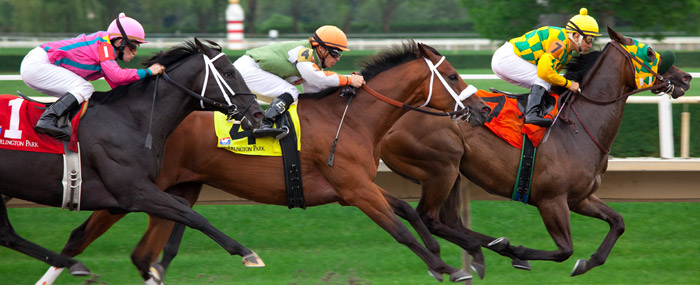-
Equitation is split into two main styles: English and Western. With markedly divergent historical origins, these two styles have distinct gaits, tack (equipment), attire, competitive events, and overall philosophies.
-
English riding evolved from fox hunting, and encompasses the most well-known competitive events including show jumping, dressage, and horse racing. Smaller saddles allow for close contact between the horse and rider, and also allow the horse to move more freely, while bridles are designed to give the rider’s hands direct contact with the horse’s mouth.
-
Western riding originated on cattle ranches in the American west, where endurance and power were priorities. Consequently, Western riding features much larger, more stable saddles, and uses one-handed neck-reining (directing the horse with light pressure on the neck with the reins) to allow the rider to work cattle with a lasso in the other hand.
-
An English riding outfit reflects the sport’s affluent origins: breeches, a fitted jacket, gloves, and tall boots are standard. Traditional Western riding attire features a cowboy hat, jeans, and Western-style boots. Many English riding disciplines place emphasis on the presentation of the horse, whereas Western styles do not.
-
International equestrian sports are dominated by English disciplines. The three Olympic equestrian sports consist of dressage, eventing, and show jumping. These events happen to be the only Olympic events that involve animals, and are also not segregated by gender, age, or any defining factor other than nationality.
-
Equitation is one of the few sports where age and gender have no impact whatsoever. The youngest ever winner at Spruce Meadows, an annual international tournament held in Calgary, was American Caitlin Ziegler, who won the Grand Prix event in 2011 at the age of 16.
- At the other end of the spectrum, Canada’s own Ian Millar, age 67, took home his third championship this year at the 2014 Spruce Meadows Master’s. Millar, who has earned the nickname ‘Captain Canada’ during his illustrious international equestrian career, holds the world record for most Olympic games attended at 10.
-
While age and gender may be irrelevant in riding, socioeconomic class is not. Equitation is historically a privileged sport, feasible only for upper-class families. The costs of lessons and leasing one’s own horse, as well as the limited availability of facilities, make equitation a prohibitively expensive and exclusionary sport.
-
The Paralympics feature para-equestrian dressage as a discipline, where conventional dressage rules apply but competitors are divided into classifications based on their disabilities.
-
The art of horse-riding is still prevalent in fields other than equitation today: mounted police have the advantage of height, mobility, and increased visibility, which help deter crime. Equine therapy is used to help those suffering from emotional or physical problems to heal in an environment designed to create connections between horse and patient.









